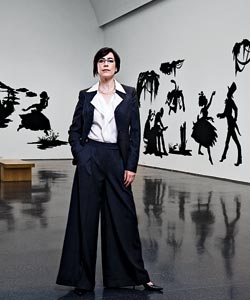|
|
Madeleine Grynsztejn, the new director of the Museum of Contemporary Art, has led a nomadic life—born in Peru, raised in Venezuela and London, schooled at the Sorbonne in Paris. In the early 1990s, she touched down in Chicago for a curatorial gig at the Art Institute, then moved on to work at Pittsburgh’s Carnegie Museum of Art and the San Francisco Museum of Modern Art.
But Chicago stuck with her—probably because it was the first city she moved to with her husband, Tom Shapiro, a nonprofit business consultant. "It was the first place where my husband and I made a home and a group of friends together, and that very much drove my sense of rootedness," she says.
At the time, the new MCA was being constructed on its present site. "I watched the building go up," she says. Now, as she watches the Art Institute’s new Modern Wing go up, the obvious question arises: How will the MCA distinguish itself? "I am predicting that the approaches will be very different," says Grynsztejn, who foresees an increase in MCA-sponsored commissions, performances, and residencies by living artists. Meantime, she has had a few conversations with James Cuno, the head of the Art Institute, about ways that they can work together. "Collaboration is the wave of the future in this city," she says.
One of Grynsztejn’s first tasks has been to rearrange the exhibition schedule. After meeting with the staff of Art Chicago, she decided to plan a concurrent exhibition of the Danish-Icelandic artist Olafur Eliasson (a show previously at the Museum of Modern Art in New York); it will now open in May 2009, the same week as the fair. Obvious, yes, but in previous years, Chicago’s cultural institutions did not align themselves with the fair, missing an opportunity to rock the city with art parties (and attract a larger audience for themselves).
Grynsztejn has also rearranged the timing of an exhibition on the architect and visionary R. Buckminster Fuller so that it will run during the Eliasson show. Both artists, although generations apart, created environmentally based work. Showing them together is all about making connections, Grynsztejn says. "It’s huge. You don’t need a book or a label or a docent. You walk into the Bucky Fuller show and you walk into Eliasson and you are done. This is how visual art should work."
Photography: Taylor Castle Photographer’s assistant: Branden Balentine Hair and Makeup: Hillary Fenton for artists Pictured in Front of KAra Walker, Presenting Negro Scenes Drawn upon my passage through the South and REconfigured for the benefit of the Enlightened audiences wherever such may be found, By myself, Missus K.E.B Walker, Colored, 1997. Mca collection, Gift of Susan and Lewis Manilow.



